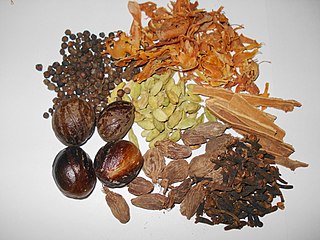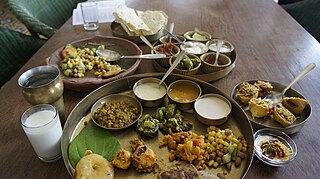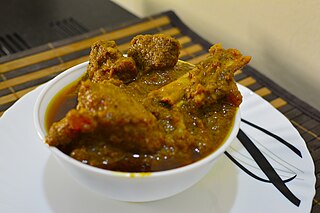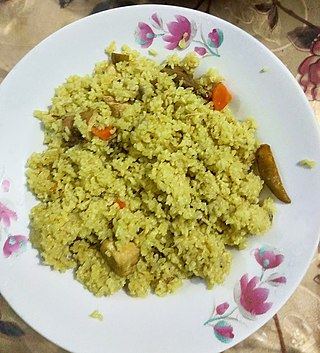
Garam masala is a blend of ground spices originating from the Indian subcontinent. It is common in Indian, Pakistani, Nepalese, Bangladeshi, Sri Lankan and Caribbean cuisines. It is used alone or with other seasonings. The specific fixings differ by district, but it regularly incorporates a blend of flavors like cardamom, cinnamon, cumin, cloves and peppercorns. Garam masala can be found in a wide range of dishes, including marinades, pickles, stews, and curries.

Spice mixes are blended spices or herbs. When a certain combination of herbs or spices is called for in a recipe, it is convenient to blend these ingredients beforehand. Blends such as chili powder, curry powder, herbes de Provence, garlic salt, and other seasoned salts are traditionally sold pre-made by grocers, and sometimes baking blends such as pumpkin pie spice are also available. These spice mixes are also easily made by the home cook for later use.

Tamil cuisine is a culinary style of Tamil people originating in the southern Indian state of Tamil Nadu and neighboring Sri Lanka. Meats, along with rice, legumes, and lentils, are also popular. Dairy products and tamarind are used to provide sour flavors. On special occasions, traditional Tamil dishes are served in a traditional manner, using banana leaves in place of utensils. After eating, the banana leaves are then used as a secondary food for cattle. A typical breakfast meal consists of idli or dosa with chutney. Lunch includes rice, sambar, curd, kuzhambu, and rasam.

Palak paneer or palak chhena is an Indian dish consisting of chhena or paneer in a thick paste made from puréed spinach, called palak in Hindi, Marathi, Gujarati, and other Indian languages.

Bangladeshi cuisine has been shaped by the region's history and river-line geography. Bangladesh has a tropical monsoon climate. The staple of Bangladesh is rice and fish. The majority of Bangladeshi people are ethnic Bengali, accustomed to Bengali cuisine, with a minority of non-Bengalis, many used to cuisines from different traditions and regions. Bangladeshi cooking features more meat dishes than the cuisine of neighbouring West Bengal, India.

Chana masala is a chickpea curry originating in the Indian subcontinent. It is a staple dish in North Indian cuisine.

Gujarati cuisine is the cuisine of the Indian state of Gujarat. The typical Gujarati thali consists of rotli, dal or curry, rice, and shaak. The thali will also include preparations made from pulses or whole beans such as moong, black eyed beans etc., a snack item (farsaan) like dhokla, pathra, samosa, fafda, etc. and a sweet (mishthaan) like mohanthal, jalebi, sevaiya etc.

Dāl bhāt is a traditional meal from the Indian subcontinent. It consists of steamed rice and a cooked lentil or other pulses stew called dal. It is a staple food in these countries. Bhāt or chāwal means "boiled rice" in a number of Indo-Aryan languages.

Shami kabab or shaami kabab is a local variety of kebab, originating from the Indian subcontinent. It is a popular dish in modern-day Indian, Pakistani and Bangladeshi cuisines. It is composed of a small patty of minced meat, generally beef, but occasionally lamb or mutton, with ground chickpeas, egg to hold it together, and spices. Shami kebab is eaten as a snack or an appetizer, and is served to guests especially in the regions of Dhaka, Deccan, Punjab, Kashmir, Uttar Pradesh and Sindh.

Madras curry or Madras sauce is a curry sauce. Madras is orange in colour and is made with heavy use of chili powder. Raita is often used as an accompaniment to the dish.

Rājmā, also known as rajmah, rāzmā, or lal lobia, is a vegetarian dish, originating from the Indian subcontinent, consisting of red kidney beans in a thick gravy with many Indian whole spices, and is usually served with rice. It is a part of the regular diet in Northern India, Nepal and Punjab province of Pakistan. The dish developed after the red kidney bean was brought to the Indian subcontinent from Mexico. Rajma Chawal is kidney beans served with boiled rice.

Baigan bharta, also spelled bainganbharta or baigan chokha is an Indian dish prepared by mashing or mincing grilled eggplant (baigan) with tomato, onion, herbs and spices, with variations being common from chef to chef. Traditionally, cooking the eggplants over charcoals, inside of a tandoor, barbecue grill or oven, or even directly applying flame to the outside of the fruit infuses the dish with a smoky flavour; the blackened skin is then easily peeled and the eggplant may be further prepared.

Malaysian Indian cuisine, or the cooking of the ethnic Indian communities in Malaysia, consists of adaptations of authentic dishes from India, as well as original creations inspired by the diverse food culture of Malaysia. Because the vast majority of Malaysia's Indian community are of South Indian descent, and are mostly ethnic Tamils who are descendants of immigrants from a historical region which consists of the modern Indian state of Tamil Nadu and Sri Lanka's Northern Province, much of Malaysian Indian cuisine is predominantly South Indian inspired in character and taste. A typical Malaysian Indian dish is likely to be redolent with curry leaves, whole and powdered spice, and contains fresh coconut in various forms. Ghee is still widely used for cooking, although vegetable oils and refined palm oils are now commonplace in home kitchens. Before a meal it is customary to wash hands as cutlery is often not used while eating, with the exception of a serving spoon for each respective dish.

Mutton curry is a dish that is prepared from goat meat and vegetables. The dish is found in different variations across all states, countries and regions of the Indian subcontinent and the Caribbean.

Chicken Lahori is a South Asian curry which originated in Lahore, Pakistan. Served with rice, chicken Lahori is a popular street food.

Akhni is a mixed rice dish with its origins among the Bengali Muslims of Chittagong and Sylhet, in eastern Bangladesh. It is often considered to be a particular variation of biryani or polao. The dish is especially popular in restaurants throughout Bangladesh, as well as among the diaspora across the world. The dish is a staple in Chittagong, where it is said to be consumed every week by the average Chittagonian person. During Ramadan, the Islamic month of fasting, the dish is popularly eaten at Iftar meals across Sylhet too.

Kala bhuna is a meat curry made of beef or mutton, originated in Chittagong, Bangladesh. Different types of spices are needed to prepare this traditional dish of Chittagong. In Bengali, the word kala or kalo means black and bhuna means deep fry. Kala bhuna gets its name from its appearance, as the meat goes blackish during a long process of deep frying it with a plenty of spices. It has become popular also in other Bangladeshi cities like Sylhet, Khulna, Dhaka etc. Nowadays, this dish is also a favorite delicacy in mezbans, weddings, eids and in sehri or iftar during the time of Ramadan. Usually, Kala bhuna is eaten with plain rice, polao, porota, naan or ruti.
Beef Hatkhora or Internationally known as Sylheti Beef; is a part of Bengali cuisine consisting of rice, satkara citrus, and beef curry. Whilst having its origins in the Sylhet Division of Bangladesh, the dish has now gained popularity across the country and among the British Bangladeshi diaspora in the United Kingdom. At the time of Eid-ul-Adha, it is a famous dish. The presence of a citrus fruit makes the dish unique among Bangladeshi curries in terms of taste and aroma. A soupy variant of the dish is made with the bones of cow feet, and in other variants, the beef is sometimes replaced with fish or other meats.

Burmese curry refers to a diverse array of dishes in Burmese cuisine that consist of protein or vegetables simmered or stewed in an aromatic curry base. Burmese curries generally differ from other Southeast Asian curries in that Burmese curries make use of dried spices in addition to fresh herbs and aromatics, and are often milder. Burmese curries are readily available in curry houses throughout the country. They are traditionally accompanied with rice and a variety of side dishes, soups, and Burmese salads called athoke. Burmese curries may also be paired with Indian breads like nanbya, palata, aloo puri, and toshay.


















